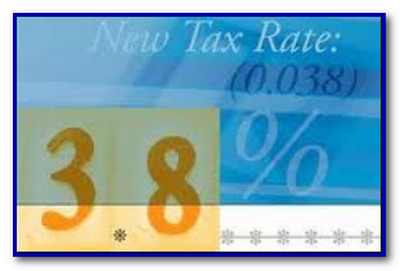The 3.8% Investment Income Tax
The 3.8% investment income tax, which is being used to help pay for health care reform, took effect January 1, 2013. The tax applies to “net investment income” for those with > $250,000 of income (joint return); $200,000 for singles. Only investment income, such as dividends, interest, and capital gains, above these dollar thresholds are taxed. The tax is a flat 3.8% in addition to other taxes owed.
Here are 16 different strategies that may help your clients avoid or minimize the 3.8% investment income tax:
Minimize AGI
A married couple filing a joint return is not subject to the tax if their AGI (found at the very bottom of the front page of Form 1040) is $250,000. If AGI is $255,000, the couple would pay an additional 3.8% on $5,000. Once the $250,000 threshold is breached ($200,000 for singles), it makes no difference where the taxable income comes from (e.g., salary, bonus, dividends, capital gains, etc.).
Some of the ways to reduce AGI are: deductible retirement plan contributions, a charitable contribution of IRA assets if the taxpayer is at least age 70 ½, moving expenses, deferred compensation, and up to $3,000 of capital losses.
Asset Rearrangement
Make a client’s portfolio more tax efficient by using tax-sheltered accounts as much as possible for highly taxable investments (i.e., taxable bonds, CDs, REIT dividends, and short-term trading). Tax-advantaged assets, such as common stocks and certain types of real estate should ideally be in taxable accounts, thereby taking advantage of long-term capital gains rates.
If a portion of a portfolio needs to be liquidated for income or due to an emergency, it is usually best to first drain non-sheltered positions.
Time the Sale
Suppose you have a single client with $150,000 of AGI and he/she wants to sell a mutual fund or ETF that has a $100,000 long-term capital gain. If the sale took place all at once, an additional $1,900 in taxes would be due (due to the 3.8% tax); however, if half the position was sold at the end of the year and then the other half was sold at the beginning of the following year, the 3.8% tax would be completely avoided.
With certain assets, it make be wise to spread out gains over a number of years by using an installment sale. A “like-kind” exchange is also possible with some assets.
Harvest Losses
Investors are often reluctant to take a loss; some believe there is no loss until the asset is actually sold. This is simply not true. A paper gain or loss affects someone’s net worth just as much as a resulting sale of that same asset. If your clients have a loss on paper and it is in a non-sheltered account, the loss should probably be recognized.
Since losses offset gains dollar for dollar (plus an additional $3,000 of losses can be used to offset taxable compensation each year), taking a loss could result in AGI being below the 3.8% tax threshold amount.
Do Not Worry About Your Home
Since a couple can exclude up to $500,000 of gain from the sale of their personal residence ($250,000 if single), few people will trigger the 3.8% tax from the sale of their home. Only gains above $500,000 (or $250,000) would be subject to the 3.8% tax, assuming the seller exceeded the income thresholds.
How Retirement Income Helps and Hurst
Taxable payments from pensions, IRAs, and Social Security are not subject to the 3.8% tax. For example, a couple with $290,000 of taxable income from Social Security and pension payments (highly unlikely) would not be subject to the 3.8% tax. However, if $100,000 of the $290,000 came from dividends, taxable interest, and capital gains, $40,000 would be subject to the 3.8% tax (since the couple is $40,000 above the $250,000 AGI threshold).
The “best” income comes from qualified Roth IRA payouts. These payouts do not raise AGI and they are not taxable. Moreover, qualified Roth payments do not help raise Medicare premiums or the possible tax on Social Security payments.
Possible Roth Conversion
Regular income taxes are due whenever a traditional IRA is converted into a Roth IRA. Still, such conversions could make sense if your client believes his/her AGI will rise to more than $250,000 or $200,000 later in retirement. This may be particularly applicable if the client is postponing Social Security benefits to age 70.
Load Up On Municipal Bonds
Interest from tax-free bonds is not used to compute the AGI threshold limits. However, income from taxable Build America Bonds is subject to the tax. Life insurance proceeds, gifts, inheritances, and appreciated assets given to charities are not subject to the 3.8% tax.
Active partners do not owe the 3.8% tax on their share of partnership business income unless the income is from trading financial instruments or commodities.
Trust Taxation
Investment income retained by a trust is subject to the 3.8% tax, but the threshold limit is a mere $11,950 of AGI, not the $200,000 or $250,000 that applies to individuals and couples. An easy way to avoid such a trust tax is to simply distribute all trust income to the trust’s beneficiaries.
Hold Investments Indefinitely
Obviously, any tax is only triggered when an asset is sold. Since everyone has a lifetime exemption of $5.25 million (CPI adjusted each year), few of your clients are going to be subject to any kind of estate tax—especially since a married couple has a $10.5 million exemption (plus anything not used by a deceased spouse can be added to the surviving spouse’s $5.25 million).
Regardless of an estate’s size, the 3.8% tax does not apply to any estate or gift tax liability. The other advantage to holding an asset until death is that your heir will receive a step-up in basis and enjoy capital gains treatment, even if you bought the asset a day before death and your heir sold it a day after your death.


